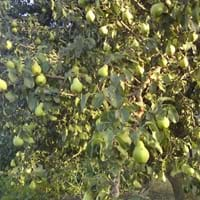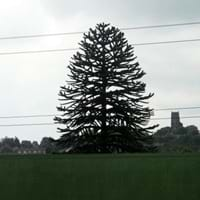Life Span
Perennial
Perennial
Type
Perennial
Needled or Scaled Evergreen
Origin
Not Available
Argentina, Chile
Types
Not Available
not available
Habitat
Hedge, hedge rows, Woodland edges
Subtropical forests
USDA Hardiness Zone
4-9
7-11
Sunset Zone
Not Available
H1, H2, 4, 5, 6, 7, 8, 9, 14, 15, 16, 17, 18, 19, 20, 21, 22, 23, 24
Habit
Upright/Erect
Oval or Rounded
Minimum Width
Not Available
Flower Color Modifier
Not Available
Bicolor
Fruit Color
Light Red, Orange, Yellow
Green
Leaf Color in Spring
Green
Green, Dark Green
Leaf Color in Summer
Green
Dark Green
Leaf Color in Fall
Green
Dark Green
Leaf Color in Winter
Light Green
Dark Green
Leaf Shape
Elliptic
Needle like
Plant Season
Spring, Summer
Spring, Summer, Fall, Winter
Sunlight
Full Sun, Partial Sun
Full Sun, Partial Sun
Growth Rate
Medium
Medium
Type of Soil
Loam, Sand
Clay, Loam, Sand
The pH of Soil
Acidic, Neutral
Acidic, Neutral, Alkaline
Soil Drainage
Well drained
Well drained
Bloom Time
Spring
Not Available
Repeat Bloomer
Not Available
No
Tolerances
Drought
Drought
Where to Plant?
Ground
Ground, Pot
How to Plant?
Seedlings
Tip cutting
Plant Maintenance
Medium
Medium
Watering Requirements
Average Water Needs, Do not water frequently
Allow to dry out slightly between watering
In Summer
Lots of watering
Lots of watering
In Spring
Moderate
Moderate
In Winter
Average Water
Average Water
Soil pH
Acidic, Neutral
Acidic, Neutral, Alkaline
Soil Type
Loam, Sand
Clay, Loam, Sand
Soil Drainage Capacity
Well drained
Well drained
Sun Exposure
Full Sun, Partial Sun
Full Sun, Partial Sun
Pruning
Remove damaged leaves, Remove dead branches, Remove dead leaves
Remove damaged leaves, Remove dead branches, Remove dead leaves
Fertilizers
All-Purpose Liquid Fertilizer
All-Purpose Liquid Fertilizer
Pests and Diseases
Red blotch
Anthracnose, Branch Droop, Root rot, Yellow Leaves
Plant Tolerance
Drought
Drought
Flowers
Showy
Insignificant
Flower Petal Number
Single
Single
Fragrant Bark/Stem
No
Yes
Foliage Texture
Medium
Fine
Foliage Sheen
Glossy
Glossy
Attracts
Not Available
Not Available
Allergy
Not Available
Not Available
Aesthetic Uses
Not Available
Showy Purposes, Used as Christmas tree
Beauty Benefits
Not Available
Not Available
Environmental Uses
Air purification
Air purification
Medicinal Uses
Astringent, Febrifuge
Not Available
Part of Plant Used
Flowers, Stem
Whole plant
Other Uses
Planted in shelterbeds, Used for woodware
Used in Furniture, Useful for shade
Used As Indoor Plant
No
Yes
Used As Outdoor Plant
Yes
Yes
Garden Design
Edible, Fruit / Fruit Tree
Container, Feature Plant
Botanical Name
PYRUS 'Ayers'
ARAUCARIA araucana
Common Name
Ayers Pear, Pear
Monkey Tail Tree, Chilean Pine, Pehuén
In Hindi
Ayers Pear
Monkey Puzzle Tree
In German
Ayers Birne
Chilenische Araukarie
In French
Ayers Poire
Araucaria du Chili
In Spanish
Ayers pera
araucaria o pehuén
In Greek
Ayers Pear
Monkey Puzzle Tree
In Portuguese
Ayers Pear
Monkey Puzzle Tree
In Polish
Ayers Gruszka
Araukaria chilijska
In Latin
Ayro Orbis
Monkey Puzzle Tree
Phylum
Tracheophyta
Pinophyta
Class
Magnoliopsida
Pinopsida
Family
Rosaceae
Araucariaceae
Clade
Angiosperms, Eudicots, Rosids
Not Available
Tribe
Not Available
Not Available
Subfamily
Not Available
Not Available
Number of Species
Not Available
Properties of Ayers Pear and Monkey Puzzle Tree
Wondering what are the properties of Ayers Pear and Monkey Puzzle Tree? We provide you with everything About Ayers Pear and Monkey Puzzle Tree. Ayers Pear doesn't have thorns and Monkey Puzzle Tree doesn't have thorns. Also Ayers Pear does not have fragrant flowers. Ayers Pear has allergic reactions like Not Available and Monkey Puzzle Tree has allergic reactions like Not Available. Compare all the properties and characteristics of these two plants. Find out which of these plant can be used as indoor plant. If you are interested to decorate your house and garden, find out aesthetic uses, compare them and select the plant which will beautify your surrounding. Along with beautification, try comparing medicinal and edible uses of Ayers Pear and Monkey Puzzle Tree and you can choose the plant having best and most benefits.
Season and Care of Ayers Pear and Monkey Puzzle Tree
Season and care of Ayers Pear and Monkey Puzzle Tree is important to know. While considering everything about Ayers Pear and Monkey Puzzle Tree Care, growing season is an essential factor. Ayers Pear season is Spring and Summer and Monkey Puzzle Tree season is Spring and Summer. The type of soil for Ayers Pear is Loam, Sand and for Monkey Puzzle Tree is Clay, Loam, Sand while the PH of soil for Ayers Pear is Acidic, Neutral and for Monkey Puzzle Tree is Acidic, Neutral, Alkaline.
Ayers Pear and Monkey Puzzle Tree Physical Information
Ayers Pear and Monkey Puzzle Tree physical information is very important for comparison. Ayers Pear height is 300.00 cm and width 300.00 cm whereas Monkey Puzzle Tree height is 1,520.00 cm and width Not Available. The color specification of Ayers Pear and Monkey Puzzle Tree are as follows:
Ayers Pear flower color: White
Ayers Pear leaf color: Green
Monkey Puzzle Tree flower color: Green
- Monkey Puzzle Tree leaf color: Green and Dark Green
Care of Ayers Pear and Monkey Puzzle Tree
Care of Ayers Pear and Monkey Puzzle Tree include pruning, fertilizers, watering etc. Ayers Pear pruning is done Remove damaged leaves, Remove dead branches and Remove dead leaves and Monkey Puzzle Tree pruning is done Remove damaged leaves, Remove dead branches and Remove dead leaves. In summer Ayers Pear needs Lots of watering and in winter, it needs Average Water. Whereas, in summer Monkey Puzzle Tree needs Lots of watering and in winter, it needs Average Water.





